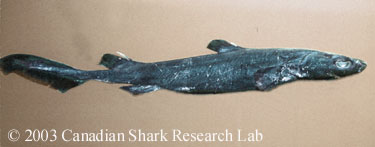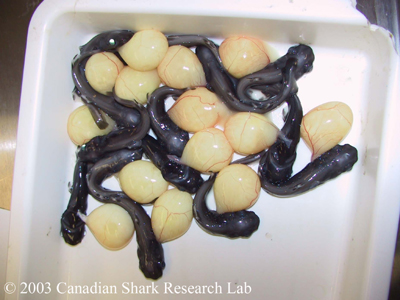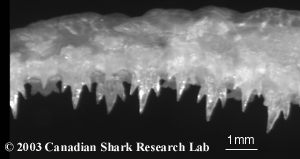Black Dogfish
Description
The black dogfish is a small deep dwelling shark with a short and heavily set body. Both of the dorsal fins have white spines on the leading edge. The second dorsal fin is larger than the first and originates over the pelvic fins. As its name suggests, this shark is completely black with the exception of the white dorsal spines. Older individuals may be a dark chocolate brown. The tricuspid teeth are similar in both the upper and lower jaws with the middle cusp being the longest.
Range
This shark species occurs only in the Atlantic Ocean basin. In the northwestern Atlantic Ocean the black dogfish can be found off southern Greenland and Baffin Island, continuing to waters around Labrador, Newfoundland, on the Scotian Shelf, and Georges Bank. Its range continues down to Cape Hatteras and possibly to Florida and into the Gulf of Mexico. It is a common shark in deep waters of some areas, such as the Gulf of St. Lawrence.
Habitat
This is a deep water shark occurring at depths of 275 to 1600 meters (975 to 5,280 feet). However in its northern range in subarctic waters, the black dogfish may occur at the surface. Water temperatures where specimens have been obtained are commonly between 3.5 to 4.5 degrees Celsius.
Life History
Average size for this shark is about 60 to 75 cm with a maximum size of 84 cm. It is thought that the black dogfish may emit light (luminescent).
Diet
This shark feeds mainly upon cephalopods, pelagic crustaceans, jellyfish, and small redfish.
Reproduction
This shark is ovoviviparous; the fertilized eggs develop within the uterus.
Interaction with People
This shark is often caught on longlines or in deep-water trawls accidentally. It is sometimes captured near the surface through ice in the winter but otherwise is seldom seen by man.



